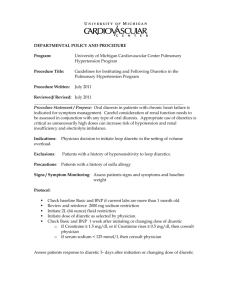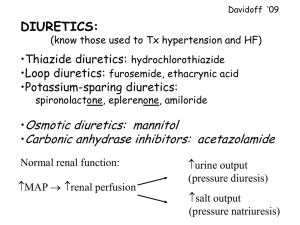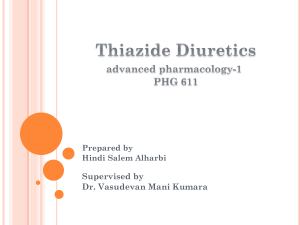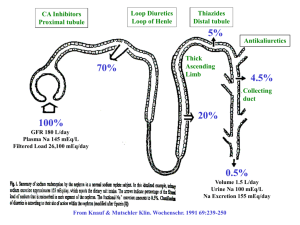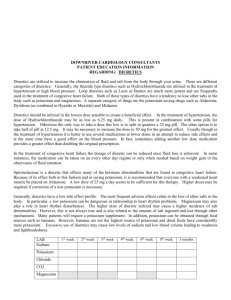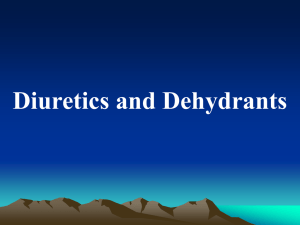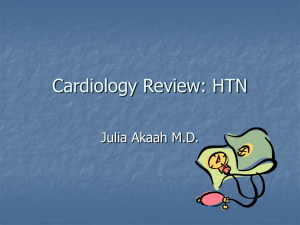10-3-07 Potassium & Magnesium Homeostasis
advertisement
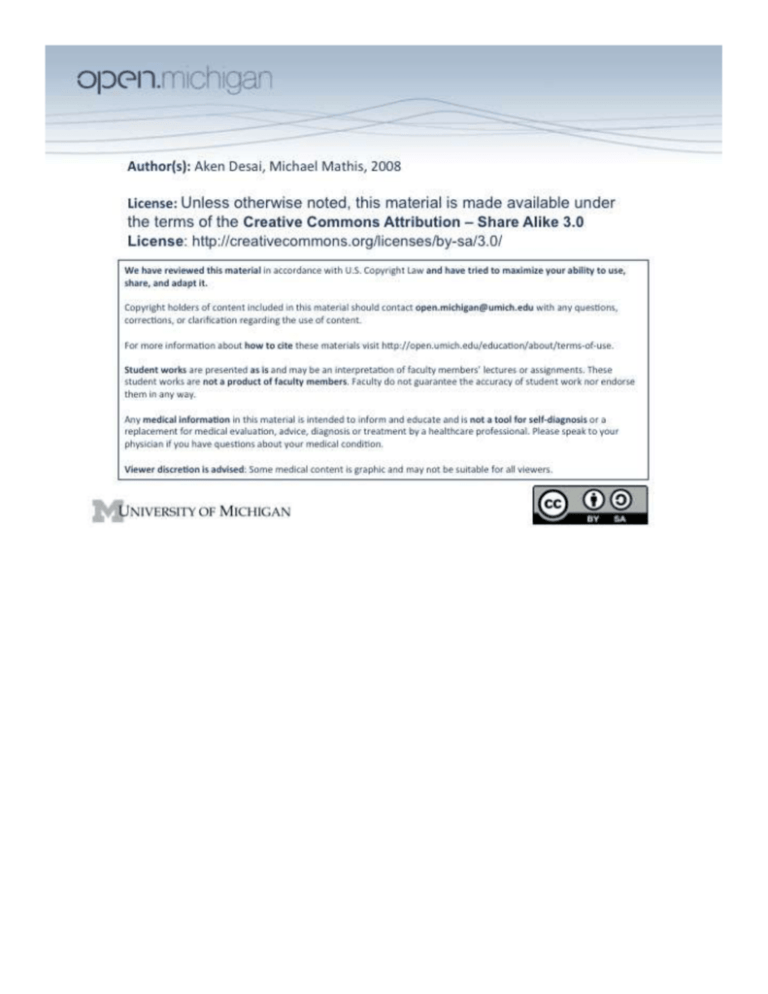
10-3-08 Diuretic Drugs Diuretics Overview “Common” Diuretics – include potassium-wasting and potassium-sparing: o Potassium-wasting: Thiazides (and thiazide-like diuretics), Loop diuretics o Potassium-sparing: Triamterene, Amiloride, Spironolactone Miscellaneous Diuretics – carbonic anhydrase inhibitors, osmotic diuretics Common Mechanism – work by increasing Na+ excretion, differ in efficacy, other solute balances, SEs Combinations – if you can achieve desired effect by increasing dose rather than adding 2 nd drug, do this! o Synergistic effects – to potentiate effects w/ multiple drug, make sure they are different classes! Diuretic Drug-drug Interactions Lithium – diuretic will potentiate lithium potency possible lithium toxicity if too potent Other diuretics – will have synergistic effects, possible leading to excess volume/solute depletion Anti-HTN – increase risk of hypotensive collapse if effects too strong Digoxin – any K-wasting diuretic will increase risk of digoxin toxicity Thiazides Thiazides – a K+-wasting diuretic, prototype is hydrochlorothiazide (HCTZ) Mechanism – act at DCT/collecting duct to prevent Na+ reabsorption Effect – will act to increase urine volume & Na + excretion: o Slight urine volume increase – due to more Na+ excreted, H2O follows o Moderate Na+ excretion – greater increase here means more concentrated urine Usage – will act to treat HTN & edema: o HTN – thiazides act primarily to treat HTN in long run… o Edema – thiazides can do a little to treat edema, but loop diuretics better o Others – Meniere’s disease (accumulation of fluid in inner ear); prophylaxis of hip fractures in elderly women (acts to decrease renal Ca loss) Kinetics – acts “slow and steady” onset ~ 1 hr, peak ~3-4 hrs, duration ~12-24 hrs Dose Response – is “flattened” increasing dosage doesn’t help too much, increases SEs more QUIZ: Na+ effect - primary effect is to excrete Na+ concentrated urine risk of hyponatremia K+ effect - K+ wasting diuretic hypokalemia… (less feedback for insulin production hyperglycemia) Mg++ effect – in parallel with K+ hypomagnesemia Ca++ effect – decreases Ca++ excretion (Ca++ makes up charge loss from Na+) hypercalcemia Glucose effect – makes cells insulin-insensitive no glucose uptake hyperglycemia/hyperlipidemia o DM Risk – thiazides can induce/exacerbate diabetes in at-risk patients b/c it counteracts the actions of all drugs used to lower blood glucose, especially sulfonylureas o Parenchymal cell “insulin resistance” – thiazide diuretics may induce prediabetic state or frank diabetes in some patients because it inhibits glucose intake Urate – decreases urate excretion hyperuricemia – watch out for gout patients… Thiazide-Like Diuretics Differences – similar to HCTZ, except varying potency, onset/duration, SEs Sulfonamide Structure – all have this similar structure sulfa drug allergy possibility… Similarities – have same pharmacologic mechanism of action, despite varying chemical structures Loop Diuretics Furosemide “Lasix” – prototype K+-wasting diuretic Mechanism – act at loop of Henle to limit counter-current multiplier effects dilute urine! Effects – will act to increase urine volume & Na + excretion o Large urine volume increase – limited countercurrent multiplier, lots of excretion o Moderate Na+ excretion – relatively smaller increase here means more dilute urine Usage – will act to treat edema & HTN, also hyponatremia, overdose recovery o Edema – loop diuretics act primarily to reduce edema large volume losses o HTN – loop diuretics can do a little to treat HTN, but thiazides better, urgent HTN = labetalol o Hyponatremia – disproportionately large fluid loss compared to Na + don’t have to worry as much about [Na+]plasma dropping too much o Overdose recovery – a “forced diuresis” can get patient to pee out drug overdosing on Kinetics – fastest of all diuretics onset < 30 min (1-2 min IV!) o Significant Na reabsorption – in ascending limb, Loop o High peak effect – will make patient output a lot, fast Dose Response – has “high ceiling” increasing dosage can still increase effects Prostaglandins – Loop diuretics operate in prostaglandin-dependent manner, thus NSAIDs can inhibit K+, Mg++ Effects – both excreted, similar to thiazide… Ca++ Effects – also excreted, risk of hypocalcemia Glucose, Urate Effects – both retained, similar to thiazide… Hypotensive Collapse – risk higher in loop diuretics than thiazides, due to large volume losses Sulfonamide-like structure – structure of loop diuretics Ototoxicity – can cause sensorineural hearing loss, along with aminoglycosides, aspirin, quinidine Alkalosis volume loss, Na+ and Cl- excretion HCO3- retention (to compensate for Cl-) alkalosis Hypokalemia K+-wasting Diuretics – obviously have risk of hypokalemia Prophylaxis & Tx – get parental K+, have K+ diet/supplement, or use K+-sparing diuretics instead + K -Sparing Diuretics Triamterene – prototype K+ sparing diuretic, also amiloride Mechanism – blocks distal Na channel (ENAC) in DCT principal cells less Na+ reabsorbed, less K+ secreted Effects – will act similarly to thiazides, except for K+ retention Usage – like thiazides, act to treat HTN (also edema a little), but also mild hypokalemia management; main use is as adjunct to K wasting Risks – similar to thiazides (hyponatremia, hypovolemia), but also hyperkalemia risk K+ Supplements – generally don’t give K+-sparing diuretic and K+ supplement one or the other… Spironolactone and Epleronone Spironolactone – K+ sparing, but different mechanism: o Aldosterone receptor blocker – blocks aldosterone action o Hyperaldosteronism – spironolactone a good choice for Tx o Side Effects – because it is shaped like a hormone, spironolactone can cause endocrine SEs Combination Diuretics – two different classes ok, don’t use 2 drugs from the same class (just as dumb as increasing dose) CA Inhibitors Acetazolamide – prototype carbonic anhydrase inhibitor, an uncommon diuretic (K+-wasting) Mechanism – inhibits CA more HCO3- increased excretion of HCO3-, drags Na+ & H2O and K+ Effects – increased excretion of alkaline urine, also inducing metabolic acidosis o QUIZ: Refractory – HCO3- “depletion” systemically means can’t use drug for too long… Usage – in general, a poor diuretic, but used in other situations: o Glaucoma – forming aqueous humour in eye requires CA can prevent this o Hydrocephalus – decreases eye pressure, then decreases brain pressure in CSF too… o Altitude Sickness – respiratory alkalosis compensated by metabolic acidosis o Epilepsy treatment, drug overdose treatment (if alkaline urine needed to excrete drug) Structure – has sulfonamide-like structure too Not Lectured: Osmotic Diuretics Mannitol – prototype osmotic diuretic, an uncommon diuretic Mechanism – IV administration sugar-like compound not taken up by cells increased osmolality o Increased osmolality – will thus induce Effects – increased osmolality fluid movement to vasculature increased GFR, increased urine Usage – maintain renal function in acute renal failure, also forced diuresis in drug OD, also reduce CSF Risks – increased vascular fluid volume HTN, CHF
